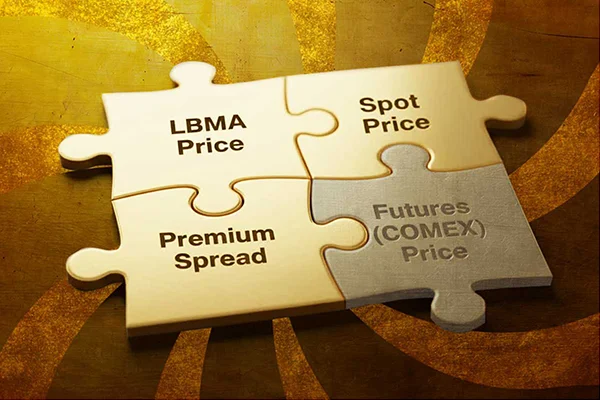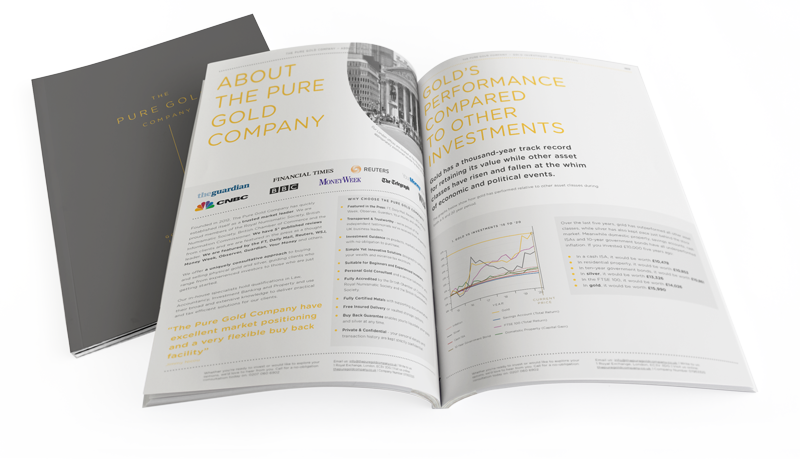Listen to article…
When you first look into buying gold, you’re immediately faced with a confusing mix of prices. You’ll see a “spot price” on a live ticker, hear reports about the “futures price” on the news, and see us at The Pure Gold Company refer to the “LBMA price” on our charts.
It’s simpler than it looks, and understanding the difference is key to being a confident investor.
At The Pure Gold Company, we deal exclusively in physical gold and silver. The price that matters most to you, as a physical gold buyer, is the LBMA Gold Price. This is the global benchmark for real, physical metal.
The other prices you see, like futures, often relate to “paper” contracts or speculation. Let’s break down what each one means in plain English.
Gold Prices: At A Glance
| Price Type | What is it in Plain English? | What is it for? | Do We Use It? |
| LBMA Price | The official, global benchmark for physical gold. | Valuing large, wholesale physical gold transactions. | Yes. This is our official benchmark for all our charts. |
| Spot Price | The “live” price you see on news tickers. | Real-time trading of gold for “on the spot” delivery. | Yes. Prices are updated in line with the LBMA benchmark and global spot pricing |
| Premium / Spread | The cost above spot (Premium) and the gap between a dealer’s buy/sell price (Spread). | Covers the cost of fabricating, insuring, and delivering a physical item. | Yes. This is a transparent part of our physical bullion transactions. |
| Futures (COMEX) Price | A price for gold to be delivered at a future date. | Speculating on future price movements (“paper trading”). | No. We deal in physical assets you can hold today, not paper contracts. |
1. The LBMA Gold Price (The Official Benchmark)
Think of the LBMA Gold Price as the official, twice-daily “snapshot” that sets the standard for the entire global physical gold industry.
- What is it? It’s a benchmark price set twice every business day (at 10:30 am and 3:00 pm London time) through a transparent, electronic auction.
- Who sets it? The auction is run by the ICE Benchmark Administration (IBA) and includes major international banks and bullion dealers who are members of the London Bullion Market Association (LBMA).
- Why it matters to you: This is the price The Pure Gold Company uses as its official benchmark. It is the most trusted and transparent price for large volumes of physical gold. When you see our charts or get a quote from our consultants, it is based on this fair, global standard.
2. The Gold Spot Price (The “Live” Price)
The “spot price” is the one you most commonly see on TV or financial websites, changing every few seconds.
- What is it? It’s the live, rolling price for one ounce of gold to be bought or sold “on the spot” for immediate delivery. It trades nearly 24 hours a day, five days a week, following the sun from when markets open in Asia on Sunday evening to when they close in New York on Friday.
- Why do charts go flat on weekends? This 24/5 trading week is the exact reason you will see the price charts go “flat” or stop moving on a Saturday and Sunday—the main global markets are closed.
- It’s priced in US Dollars (USD): This is a critical point. The global gold price is set in USD. The price you see in Pounds (GBP) or Euros (EUR) is the USD spot price converted using the live currency exchange rate. This means the price in Pounds can change simply because the GBP/USD exchange rate has moved, even if the main gold price hasn’t.
- Why it matters to you? Because the spot price is quoted in USD, your actual cost to buy and value to sell in the UK is influenced by both the gold market and the GBP/USD exchange rate. If the Pound weakens against the Dollar, the price you pay for gold in Pounds may rise even if the global gold price stays flat. Equally, if the Pound strengthens, the local price can fall. Understanding this helps you recognise whether price movements are driven by genuine shifts in the gold market, currency movements, or a combination of the two. In other words, following both gold price trends and exchange rates gives you a clearer view of when you may want to buy or sell.
From Ounces to Grams and Coins
It’s easy to get confused by weights, but it’s very simple when you know the standard unit.
- It’s a Troy Ounce: The global spot price is for one troy ounce of gold. A troy ounce (31.1035 grams) is the standard measurement for precious metals and is slightly heavier than a regular “food” ounce (28.35 grams).
- How to find the gram price: To find the spot price per gram, you simply divide the price of one troy ounce by 31.1035.
- Where do coins fit in? A one-ounce gold coin (like a Gold Britannia or Gold Sovereign) contains one troy ounce of pure gold. Its base value is therefore the live spot price of one troy ounce. The same logic applies to bars.
Spot Price vs. Your Purchase Price (Premium & Spread)
This is the most important concept for a new physical investor to understand. You are unlikely to be able to buy a gold coin or bar for the spot price.
The spot price is the “wholesale” cost for a large, 400-troy-ounce “Good Delivery” bar sitting in a vault. The price you pay for your coin or bar is the spot price + a ‘premium’.
This premium isn’t a hidden fee. It is the real-world cost of:
- Manufacturing: Taking that raw gold and minting it into a beautiful, intricate coin (like a Gold Sovereign) or a precisely-weighed gram bar.
- Assaying: Officially testing and certifying the purity and weight of your item.
- Insurance & Delivery: Securely storing, insuring, and delivering the finished product to you.
- Demand: Smaller denomination coins, for example, are generally in higher demand, due to their divisibility. That makes them more expensive to buy, and also means they command a higher premium when it is time to sell.
This brings us to another important and related term: the ‘spread’.
While people often use “premium” and “spread” to mean the same thing, they are slightly different:
- The Premium is the one-way cost added to the spot price to create the final retail price you pay (this is called the “Ask” price).
- The Spread is the two-way difference between the price a dealer sells a coin for (the “Ask”) and the price they will buy it back for (the “Bid”).
The premium is the main component that creates the spread. It covers all the business costs (fabrication, shipping, insurance, etc.) that allow a dealer to provide a “two-way market” (both buying and selling) for that specific product.
3. The Futures Price & COMEX (The “Paper” Price)
You will often hear about the “gold futures” price or the “COMEX” price. It’s vital to understand that this is not the price for physical gold you can hold today.
- What is it? A futures price is a bet on what gold will be worth at a specific date in the future. Traders use these “paper contracts” to speculate on price movements without ever intending to touch the actual metal.
- What is COMEX? COMEX is simply the main marketplace (an exchange in New York) where these paper futures contracts are bought and sold.
- Why it’s not relevant to you: This market is used by speculators, miners, and large institutions, often using leverage (debt) to make bets. At The Pure Gold Company, we don’t deal in “paper gold.” We believe in owning the actual, physical asset. The futures market can influence the spot price, but it is not the price you pay for a real coin or bar.
How All These Prices Fit Together (The “Dog and the Tail”)
So, how do the LBMA benchmark, the 24/5 spot price, and the COMEX futures market all relate?

Think of it this way:
- COMEX (Futures) often wags the “paper” price: The COMEX futures market involves a massive amount of “paper” trading (bets on the future price). Because this market is so huge, its activity often causes the live spot price to move up or down second-by-second.
- The Spot Price is the “live” result: The spot price you see on a live ticker is the 24/5 global price that is constantly reacting to both the COMEX paper market and the real-world physical demand.
- The LBMA Price is the “physical anchor”: The LBMA price is the official benchmark that brings the price back to physical reality. It’s set by an auction of real, physical metal.
This is why explaining futures is so important, even though we don’t sell them. The ‘noise’ from the paper futures market is often what causes the daily volatility you see on the news.
As a physical gold buyer, this allows you to separate the signal from the noise. The noise is the short-term paper trading on COMEX. The signal is the long-term, stable value of physical gold, which is anchored by the LBMA benchmark.


